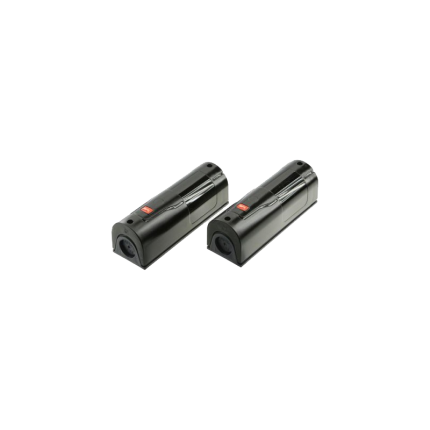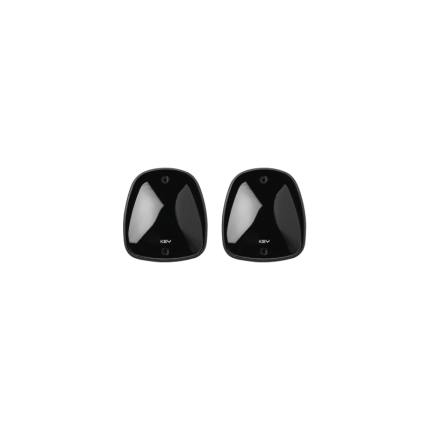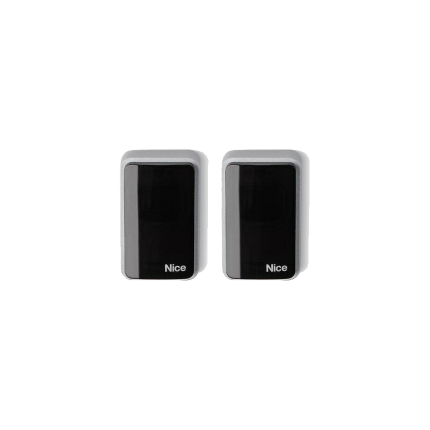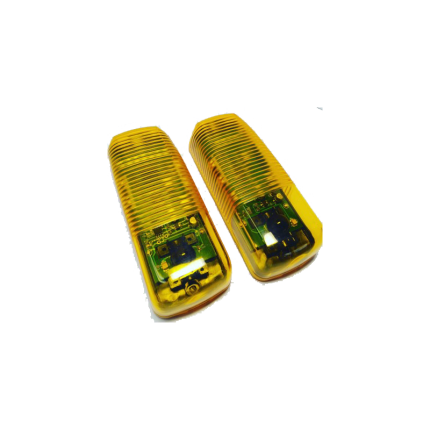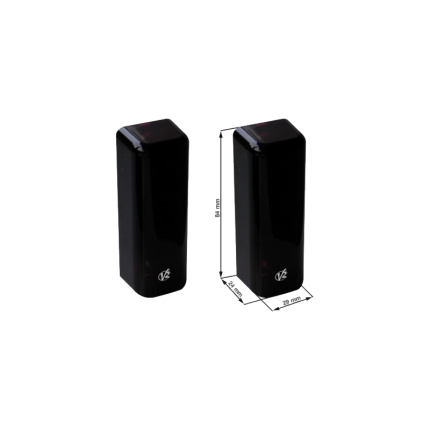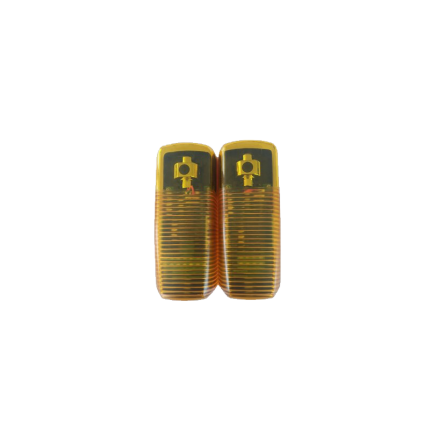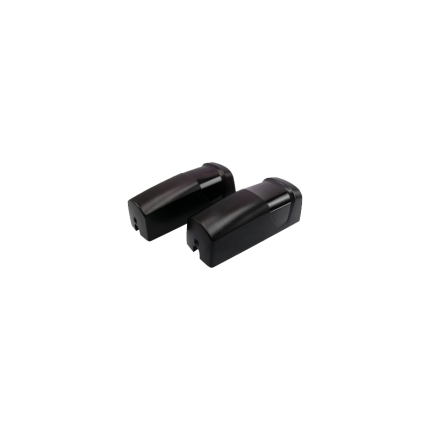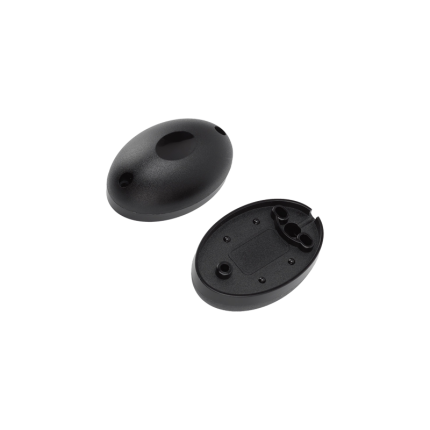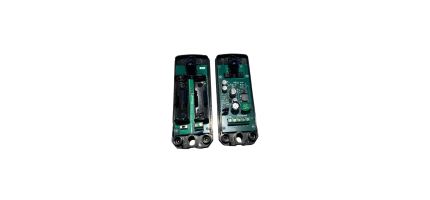photoelectric
Safety sensor – BFT FL130
Ship or pick up from our office.
Safety sensor - BFT FL130
The BFT FL130 is a photoelectric safety sensor designed primarily for use with automated gates and doors. It's a crucial safety component that prevents the gate or door from closing if an obstacle, such as a person or vehicle, is detected in its path. Here's a breakdown of its key aspects: How it Works The BFT FL130 operates as a pair of photocells, consisting of a transmitter (TX) and a receiver (RX). These units are typically mounted on opposite sides of the gate or door opening. The transmitter emits an infrared beam towards the receiver. If anything breaks this beam (e.g., a person walking through, a car passing), the receiver detects the interruption and sends a signal to the gate's control unit. This signal then triggers a safety mechanism, causing the gate to stop its movement or reverse direction to avoid impact. Features and Specifications- Type: Photoelectric safety sensor (photocell).
- Components: Transmitter and receiver pair.
- Function: Detects obstacles in the path of automated gates and doors to prevent accidents.
- Detection Method: Infrared beam.
- Applications: Commonly used in residential and commercial settings for automated swing gates, sliding gates, and garage doors.
- Max Range: Up to 30 meters (can be reduced by 50% in adverse weather conditions like fog or heavy rain).
- Power Supply: Typically 20-31 VAC or 22-30 VDC.
- Absorption: Approximately 70mA per pair.
- Relay Contacts: 1A at 24 VAC-DC.
- Working Temperature: Generally from -15°C to +70°C (some sources say -5°C to +70°C).
- Protection Rating: IP54, meaning it's protected against dust ingress and splashing water.
- Mounting: Should be aligned and mounted at a height between 40 and 60 cm from the ground on flat, parallel surfaces.
- Dimensions: Compact, typically around 115mm x 32mm x 26mm.
- Versions: There is also a BFT FL130B version, which may offer additional features like self-alignment and is designed to meet EN12453 regulations for Type D safety devices when connected to a compatible control unit that verifies safety device functionality.
Safety Sensor – Key Automation 900FT33
Ship or pick up from our office.
Safety Sensor - Key Automation 900FT33
- NO/NC
- AC 10-30 V / DC 10-40 V
- Receiving Range: 25 Meters
- IP 54
Safety sensor – Nice Era-EPM
Ship or pick up from our office.
Safety sensor - Nice Era-EPM
The Nice Era-EPM is a photoelectric safety sensor commonly used in automation systems for gates, garage doors, barriers, and similar installations. It's also often referred to as a photocell or beam sensor. Here's a breakdown of what it is and its key features: Purpose: Its primary function is to enhance safety by detecting obstacles in the path of a moving gate or door. It consists of a transmitter (TX) and a receiver (RX) that are installed facing each other. The transmitter emits an infrared beam, and if this beam is interrupted by an object, the receiver signals the control unit to stop or reverse the automation system, preventing accidents, injuries, or damage to vehicles. Key Features and Specifications:- Photoelectric Technology: It uses an infrared beam to detect obstructions.
- Transmitter (TX) and Receiver (RX): Comes as a pair, with one unit transmitting the beam and the other receiving it.
- Relay Output: It's a relay photocell, meaning it sends a signal to the control unit via a relay output.
- Range: Typically has a useful range of 15 meters, which can be extended up to 30 meters in some configurations (e.g., by cutting a "+10m" electrical bridge). However, range can be reduced in adverse weather conditions like fog, rain, or dust.
- Anti-Glare Circuitry: Designed with an anti-glare circuit to minimize interference from sunlight, ensuring reliable performance in various lighting conditions.
- Durable Construction: Features an ABS body that is resistant to weather conditions, making it suitable for outdoor use (IP44 protection rating).
- Easy Installation: Known for its simplified assembly and installation procedure. Some versions (like those with Nice BlueBUS technology) require only two wires for connection to compatible control units, simplifying wiring.
- Wide Angle of Reception: Generally has a 10° (or 8° with a reduction cone) angle of reception, which helps in compensating for minor alignment issues.
- Compatibility: While it's a Nice-branded product, it's often described as a "universal photocell" compatible with most gate and garage door automation systems, especially those that accept standard relay inputs. Some models also feature Nice BlueBUS technology for seamless integration with Nice control units that support it.
- Safety Compliance: It is a Type D presence detector according to EN 12453 standard, which means it detects obstacles on the optical axis. When connected to a control unit with a "phototest" function, it can achieve Category 2 safety against malfunctions according to EN 954-1.
Safety sensor – P51033H
Ship or pick up from our office.
Safety sensor - P51033H
*NO/NC *AC/DC 12-24 V *Receiving Range: 12 Meters *IP 54 *External LED flash lamp signal (AC/DC 12V-24 V) *The safety sensor included the LED flash lightSafety sensor – V2 Sensiva XS
Ship or pick up from our office.
Safety sensor - V2 Sensiva XS
*NO/NC *AC 12-24 V / DC 21-36 V *Receiving Range: 20 Meters *IP 44Discover the SENSIVA V2 Safety Sensor
The SENSIVA V2 photocells are innovative safety devices designed to provide optimal protection for your automated gates and garage doors. Using an infrared beam, they efficiently detect obstacles to stop or reverse the gate's movement, thus preventing any risk of collision or accident. With their compact design and advanced synchronization technology, they easily integrate into any type of installation, offering a reliable and durable solution for both indoor and outdoor environments.Technical Specifications
- Power Supply: 12-24 V AC / 12-36 V DC
- Range: Up to 20 meters for the SENSIVA-XS model, and 25 meters for the standard SENSIVA model
- Protection Rating: IP54, resistant to dust and water splashes
- Orientation: Head adjustable horizontally up to 180° and vertically up to 30° (SENSIVA only)
- Dimensions: 84 x 29 x 24 mm (SENSIVA-XS) and 86 x 41 x 38 mm (SENSIVA)
- Operating Temperature: -20°C to +60°C
- Manual: Digital (QR Code) with simple and quick installation
Key Features
- Maximum Safety: Accurate and reliable obstacle detection to prevent accidents.
- Synchronization: Advanced technology to prevent interference between multiple pairs of photocells.
- Versatile Installation: Compatible with wall or post installations (SENSIVA-XS).
- Weather Resistance: IP54 rating and optimal operation under extreme conditions.
- Adjustable Orientation: Easy configuration to fit all installations (SENSIVA model).
Why Choose the SENSIVA V2 Photocells?
- Reliability: Ensure the safety of your automated gates with precise and effective obstacle detection.
- Modern Technology: Anti-interference synchronization and protection against sunlight.
- Durability: Resistant to wear and weather conditions thanks to robust design and high-quality materials.
- Flexibility: Two models to meet all needs: compact (SENSIVA-XS) or standard (SENSIVA).
Safety sensor FO-MATIC
Ship or pick up from our office.
Safety sensor FO-MATIC
*NO/NC *AC/DC 12-24 V *Receiving Range: 15 Meters *IP 44Safety sensor FT2008
Ship or pick up from our office.
Safety sensor FT2008
*NO/NC *AC/DC 12-24 V *Receiving Range: 15 Meters *IP 44A gate opener safety sensor is a device designed to detect objects or people in the path of an automatic gate and prevent it from closing or hitting them, ensuring safety and preventing damage or injury.
These sensors can be photoelectric, pressure sensors, magnetic sensors, or loop detectors and are crucial for preventing accidents and ensuring smooth gate operation.
Types of Gate Opener Safety Sensors:
-
Photoelectric Sensors:These sensors use an infrared beam to detect objects. When the beam is broken by an object, the gate opener is signaled to stop or reverse.
-
Pressure Sensors:These sensors are typically located along the edge of the gate and detect pressure when the gate comes into contact with an object.
-
Magnetic Sensors:These sensors use a magnetic field to detect the presence of vehicles or objects near the gate.
-
Loop Detectors:These sensors use a wire loop buried in the ground near the gate. When a vehicle or object passes over the loop, it triggers the gate to stop or reverse.
How They Work:
- Detection: The sensor detects the presence of an object or person in the gate's path.
- Signal: The sensor sends a signal to the gate operator.
- Action: The gate operator responds by stopping, reversing, or remaining open, depending on the sensor type and programmed settings.
Importance of Safety Sensors:
- Prevent Accidents: They protect people and vehicles from being hit by the gate.
- Prevent Damage: They help avoid damage to the gate, vehicles, or property.
- Ensure Reliable Operation: They contribute to the smooth and safe operation of the gate.
Safety sensor P51022H
Ship or pick up from our office.
Safety sensor P51022H
*NO/NC *AC/DC 12-24 V *Receiving Range: 12 Meters *IP 54 *External LED flash lamp signal (AC/DC 12V-24 V) *Internal Rotation system: 0~180Safety Sensor P52000H
Ship or pick up from our office.
Safety Sensor P52000H
IP Rating: IP54
Certification: CE
Working Voltage: 12V-24V AC/DC
Temperature Rane: -20ºC to 60 ºC
Protection Index: IP54
Photocell Wavelength: 940nm
Receiver Range: More Than 12m
Weight: 139g
A gate opener safety sensor is a crucial component of automated gate systems designed to prevent accidents and damage by detecting obstructions in the gate's path.
These sensors, often photoelectric, use an infrared beam to monitor the area and trigger the gate to stop or reverse if something is blocking its movement.
How it works:
-
Transmitter and Receiver:A safety sensor typically consists of a transmitter that emits an infrared light beam and a receiver that detects the beam.
-
Obstruction Detection:When an object, person, or vehicle interrupts the beam, the receiver signals the gate operator to stop or reverse the gate's movement.
-
Safety Feature:This mechanism prevents the gate from closing on anything or anyone, ensuring safety and preventing potential damage.
Types of Safety Sensors:
-
Photoelectric Sensors (Photo Eyes):These are the most common type, using an infrared beam to detect obstructions.
-
Safety Edges:These sensors are typically placed along the edge of the gate and trigger a stop or reverse when they encounter pressure.
-
Induction Loops:These sensors are embedded in the ground and detect vehicles as they pass over them, triggering the gate to open or close.
Importance:
-
Safety:The primary function is to prevent accidents and injuries by stopping or reversing the gate when an obstruction is present.
-
Preventing Damage:By detecting obstructions, these sensors help avoid damage to the gate, vehicles, or anything else in its path.
-
Compliance:Safety sensors are often required for automated gates to meet safety regulations and standards.
Common Issues:
-
Misalignment:If the sensor is misaligned, the infrared beam may not reach the receiver, causing the gate to malfunction.
-
Obstructions:Debris, dirt, or other obstructions can interfere with the beam and trigger false alarms.
-
Sensor Failure:Like any electronic device, sensors can fail over time, requiring replacement.
Safety Sensor S300
Ship or pick up from our office.
Safety Sensor S300
A gate opener safety sensor is a crucial component of automated gate systems designed to prevent accidents and damage by detecting obstructions in the gate's path.
These sensors, often photoelectric, use an infrared beam to monitor the area and trigger the gate to stop or reverse if something is blocking its movement.
How it works:
-
Transmitter and Receiver:A safety sensor typically consists of a transmitter that emits an infrared light beam and a receiver that detects the beam.
-
Obstruction Detection:When an object, person, or vehicle interrupts the beam, the receiver signals the gate operator to stop or reverse the gate's movement.
-
Safety Feature:This mechanism prevents the gate from closing on anything or anyone, ensuring safety and preventing potential damage.
Types of Safety Sensors:
-
Photoelectric Sensors (Photo Eyes):These are the most common type, using an infrared beam to detect obstructions.
-
Safety Edges:These sensors are typically placed along the edge of the gate and trigger a stop or reverse when they encounter pressure.
-
Induction Loops:These sensors are embedded in the ground and detect vehicles as they pass over them, triggering the gate to open or close.
Importance:
-
Safety:The primary function is to prevent accidents and injuries by stopping or reversing the gate when an obstruction is present.
-
Preventing Damage:By detecting obstructions, these sensors help avoid damage to the gate, vehicles, or anything else in its path.
-
Compliance:Safety sensors are often required for automated gates to meet safety regulations and standards.
Common Issues:
-
Misalignment:If the sensor is misaligned, the infrared beam may not reach the receiver, causing the gate to malfunction.
-
Obstructions:Debris, dirt, or other obstructions can interfere with the beam and trigger false alarms.
-
Sensor Failure:Like any electronic device, sensors can fail over time, requiring replacement.

